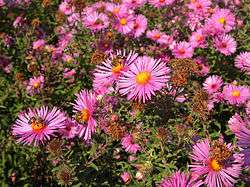Symphyotrichum novae-angliae
| Symphyotrichum novae-angliae | |
|---|---|
 | |
| New England aster | |
| Scientific classification | |
| Kingdom: | Plantae |
| Clade: | Angiosperms |
| Clade: | Eudicots |
| Clade: | Asterids |
| Order: | Asterales |
| Family: | Asteraceae |
| Genus: | Symphyotrichum |
| Subgenus: | Symphyotrichum subg. Virgulus |
| Species: | S. novae-angliae |
| Binomial name | |
| Symphyotrichum novae-angliae | |
| Cultivars | |
| Synonyms | |
| |
Symphyotrichum novae-angliae (L.) G L Nesom. (formerly Aster novae-angliae L.), commonly known as the New England aster,[2] hairy Michaelmas-daisy[3] or Michaelmas daisy, is a flowering herbaceous perennial plant in the Asteraceae family. It is native to almost every area in North America east of the Rocky Mountains, but excluding the far north of Canada as well as some of the southern United States.
Symphyotrichum novae-angliae was introduced to Europe in 1710;[4] a common garden escape, it has naturalized along roadsides and on disturbed ground.
Description

The plant grows up to 120 cm (47 in) with a stout, hairy stem and clasping, lance-shaped leaves with entire margins. The flower heads are showy with yellow disc florets at the center and ray florets that range from a deep purple or rose to rarely white.
This species inhabits a wide variety of habitats and soil types, though it does not tolerate strong shade.
Uses among Native Americans
The Cherokee use a poultice of the roots for pain, an infusion of the roots for diarrhea, and sniff the ooze from the roots for catarrh. They also take an infusion of the plant for fever.[5] The Chippewa smoke the roots in pipes to attract game.[6] The Iroquois use a decoction of the plant for weak skin, a decoction of the roots and leaves for fevers, the plant as a "love medicine",[7] and an infusion of whole plant and rhizomes from another plant to treat mothers with intestinal fevers.[8] The Meskwaki smudge the plant and use it to revive unconscious people,[9] and the Prairie Potawatomi use it as a fumigating reviver.[10]
Cultivation
Owing to its attractive flowers, numerous cultivars have been developed. Moreover, as a result of its increased horticultural popularity, it has been introduced to many areas beyond its natural range, including Europe and several western US states.[11]
Cultivars
See List of Symphyotrichum novae-angliae cultivars.
Over 70 cultivars of Symphyotrichum novae-angliae have been raised, although only about 50 survive in commerce today. There is less diversity of habit and flower than in novi-belgii, whose cultivars are often derived from hybrids. The novae-angliae cultivars grow to between 90 and 180 cm in height, with the notable exception of "Purple Dome", at <60 cm.[4]
Collections
In the United Kingdom, there is one NCCPG national collection of Symphyotrichum novae-angliae.
See also
References
- ↑ "Symphyotrichum novae-angliae". NatureServe Explorer. NatureServe. Retrieved 2007-06-18.
- ↑ "Symphyotrichum novae-angliae". Natural Resources Conservation Service PLANTS Database. USDA. Retrieved 6 December 2015.
- ↑ "BSBI List 2007". Botanical Society of Britain and Ireland. Archived from the original (xls) on 2015-01-25. Retrieved 2014-10-17.
- 1 2 "Aster novae-angliae (New England Aster; Michaelmas Daisy)". Colwall, United Kingdom: The Picton Garden and Old Court Nurseries.
- ↑ Hamel, Paul B. and Mary U. Chiltoskey 1975 Cherokee Plants and Their Uses – A 400 Year History. Sylva, N.C. Herald Publishing Co. (p. 24)
- ↑ Densmore, Frances 1928 Uses of Plants by the Chippewa Indians. SI-BAE Annual Report #44:273-379 (p. 376)
- ↑ Herrick, James William 1977 Iroquois Medical Botany. State University of New York, Albany, PhD Thesis (p. 463)
- ↑ Rousseau, Jacques 1945 Le Folklore Botanique De Caughnawaga. Contributions de l'Institut botanique l'Université de Montréal 55:7-72 (p. 65)
- ↑ Smith, Huron H. 1928 Ethnobotany of the Meskwaki Indians. Bulletin of the Public Museum of the City of Milwaukee 4:175-326 (p. 212)
- ↑ Smith, Huron H. 1933 Ethnobotany of the Forest Potawatomi Indians. Bulletin of the Public Museum of the City of Milwaukee 7:1-230 (p. 50)
- ↑ Brouillet, Luc; Semple, John C.; Allen, Geraldine A.; Chambers, Kenton L.; Sundberg, Scott D. (2006). "Symphyotrichum novae-angliae". In Flora of North America Editorial Committee. Flora of North America North of Mexico (FNA). 20. New York and Oxford – via eFloras.org, Missouri Botanical Garden, St. Louis, MO & Harvard University Herbaria, Cambridge, MA.
External links

